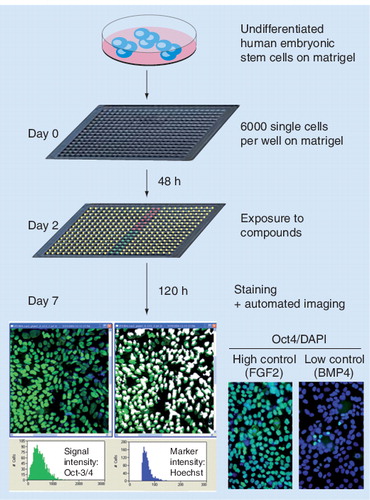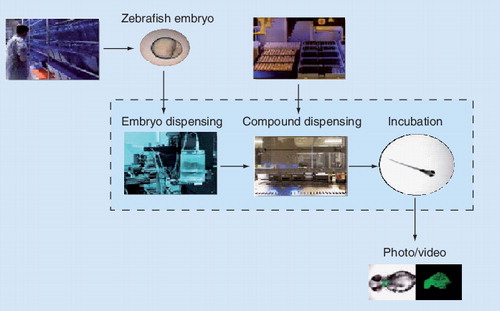Figures & data
The cells were exposed to a total of 2800 different chemical entities and subsequently stained for Oct4 expression as a marker for the undifferentiated state. Reproduced courtesy of Sabrina Desbordes, Center for Genomic Regulation, Barcelona, Spain.

HEK293T cells expressing a fluorescence reporter for cell viability are directly cocultivated with the pathogen of interest (Staphylococcus aureus). (A) In the presence of a noncytotoxic, specific antibiotic (e.g., penicillin/streptomycin), the human reporter cells survive and generate a strong readout signal (inset); whereas, (B) in the absence of a specific antibiotic, the pathogen outgrows the human reporter cells, resulting in shutdown of the readout signal Citation[10].
![Figure 2. Screening compounds simultaneously for the inhibition of bacterial growth and cytotoxicity in human cells.HEK293T cells expressing a fluorescence reporter for cell viability are directly cocultivated with the pathogen of interest (Staphylococcus aureus). (A) In the presence of a noncytotoxic, specific antibiotic (e.g., penicillin/streptomycin), the human reporter cells survive and generate a strong readout signal (inset); whereas, (B) in the absence of a specific antibiotic, the pathogen outgrows the human reporter cells, resulting in shutdown of the readout signal Citation[10].](/cms/asset/1ae4b907-f3fe-474a-99a6-5fca9bc6abe1/iero_a_11214286_f0002_b.jpg)
Zebrafish embryos show 85% genetic homology with humans and develop rapidly. This allows the screening of several thousand samples at costs similar to cell-based screens.
Reproduced courtesy of Carlos Callol-Massot, Biobide S.L., San Sebastian, Spain.
